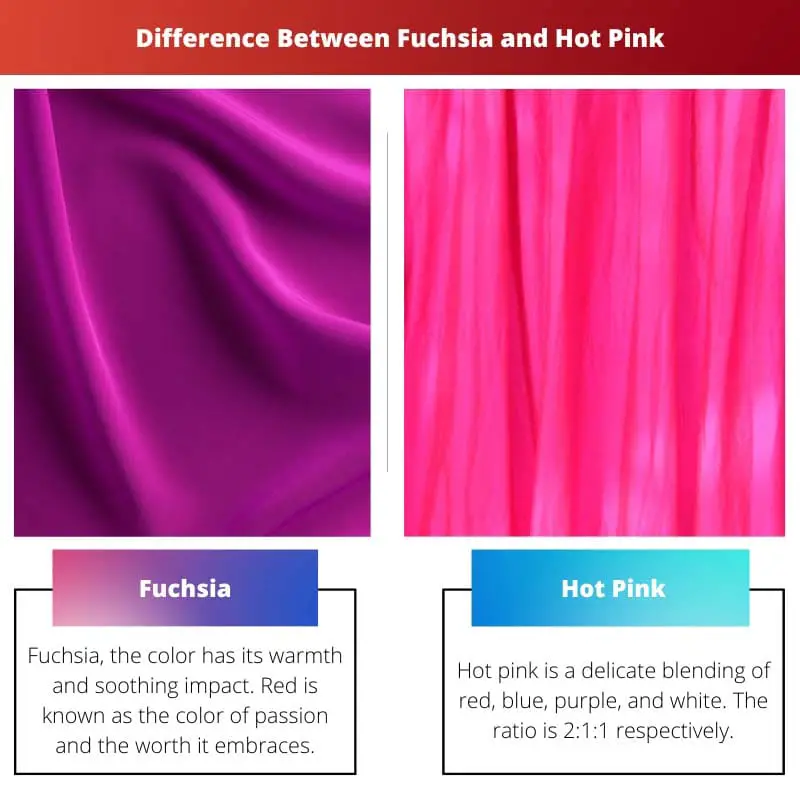The perception of the world is through light and dark, the colors and its essence. Each color has a psychological significance. Here we will be talking about the shades of pink.
To differentiate between fuchsia and hot pink, we might look into their saturation, texture, lightness, tint and so on.
Key Takeaways
- Fuchsia is a bright, vivid shade of pink with a purple undertone, whereas hot pink is a bold, intense pink without a purple undertone.
- Fuchsia is named after the flowering plant, while hot pink was popularized in the 1940s and 1950s fashion industry.
- Fuchsia appears darker and more saturated than hot pink, with a brighter and more neon-like quality.
Fuchsia vs Hot Pink
Fuchsia is a reddish-purple or purplish-red color that is brighter, vivid, and louder than hot pink. It is similar to magenta and is named after the color of the flower of the fuchsia plant. Hot pink is a brighter, more vivid pink between light and dark pink. It is less bright than fuchsia.

Fuchsia, the color has its warmth and soothing impact. Red is known as the color of passion and the worth it embraces. And the purple color with its richness and royalty.
These colors when blended give the fuchsia pink which also resembles magenta. However, the fascinating fuchsia flower gives it its name.
Hot pink is a delicate blending of red, blue, purple, and white. The ratio is 2:1:1 respectively. The color can be ranged between the darker and the lighter shades of pink.
The color is predominantly feminine. It is known for its sensual vibe, warmth, and delicate.
Comparison Table
| Parameters of comparison | Fuchsia | Hot Pink |
|---|---|---|
| Shade | Reddish purple | Pinkish tint |
| Hex code | FF00FF | FF69B4 |
| Brightness | More | Less |
| Is it similar to magenta? | Yes | No |
| Psychological significance | Nurturing love | Sensual love |
What is Fuchsia?
Determining a shade of color is the perception of your eyesight. Even a shade lighter or darker makes a huge difference if you are painting on a canvas. Fuchsia is one of such fascinating colors with a fancy name.
The fuchsia flower is the inspiration behind the name of the color. The natural shade of the color justifies the vibrant hue of the color fuchsia. Perhaps there is some other captivating history attached with the discovery of the color fuchsia.
The color is interchangeably referred to as magenta overtimes. The discovery of the flower was in 1892. The blending of red-purple and pink in appropriate proportion results in the color fuchsia.
As everything in the human world has a psychological significance. An empathy that describes emotions and makes a non-living thing lively. The color is symbolic of boldness, the innocence in pure love and responsibility.
Its bright shade depicts assurance and positivity. In a color wheel, you can find the shade in between purple and pink. The color having a pinkish tint is found on feminine catalogs (make-up, magazines, etc).
The hex color code of the color is FF00FF. This is a special code that gives the shade a unique identification in the world of colors.

What is Hot Pink?
While blending a shade of color the proportions are very critical, they must be just enough. In the case of hot pink, the fusion of red, blue, and purple are mixed precisely with white to balance the adequate brightness.
The saturation and the tint are vital when it comes to designating a particular shade of color. These are the basic characteristics of color. Hot pink has the unique ID FF69B4.
In contrast to fuchsia, hot pink is not as bright as the former. In the color chart, you can find hot pink in between dark and light pink. The fuchsia has a brighter purple tint in contrary to hot pink.
We kept evolving with time and so is our sense of color. It was not until the 17th century that the color pink was discovered. Then it was the 18th century perhaps when its essence was illustrated into the painting (pastel color, Europe).
Pink has since then been known for its tenderness and sensuality. It implies passion and love yet is delicate. Artists used pink to depict sensual essence in their artwork in the era.
The color became more popular among women and thus it attached “feminine” as its adjective. It was 1849 when hot pink was first ever talked about.

Main Differences Between Fuchsia and Hot Pink
- Fuchsia is named after a flower whereas hot pink is a shade of pink.
- Fuchsia is brighter than hot pink.
- Fuchsia is a combination of red, purple, and pink whereas hot pink is the blending of white color with blue, purple, and red.
- Fuchsia was discovered in 1892 and hot pink was discovered in 1849.
- Fuchsia is similar to magenta whereas hot pink is not.
- Fuchsia is coded as FF00FF and hot pink is coded as FF69B4.

- https://journals.flvc.org/fshs/article/download/87457/84290
- https://oatd.org/oatd/record?record=florida%5C%3Aetd%5C%3AUFE0021376
